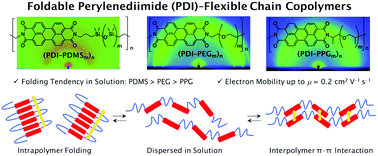当前位置:
X-MOL 学术
›
Mater. Chem. Front.
›
论文详情
Our official English website, www.x-mol.net, welcomes your feedback! (Note: you will need to create a separate account there.)
Electron-transporting foldable alternating copolymers of perylenediimide and flexible macromolecular chains†
Materials Chemistry Frontiers ( IF 7 ) Pub Date : 2018-02-20 00:00:00 , DOI: 10.1039/c7qm00616k Tsuneaki Sakurai 1, 2, 3, 4, 5 , Naomi Orito 1, 2, 3, 4, 5 , Shusaku Nagano 5, 6, 7, 8 , Kenichi Kato 5, 9, 10 , Masaki Takata 5, 9, 10 , Shu Seki 1, 2, 3, 4, 5
Materials Chemistry Frontiers ( IF 7 ) Pub Date : 2018-02-20 00:00:00 , DOI: 10.1039/c7qm00616k Tsuneaki Sakurai 1, 2, 3, 4, 5 , Naomi Orito 1, 2, 3, 4, 5 , Shusaku Nagano 5, 6, 7, 8 , Kenichi Kato 5, 9, 10 , Masaki Takata 5, 9, 10 , Shu Seki 1, 2, 3, 4, 5
Affiliation

|
Tuning the electrical conductivity of conjugated macromolecules by nanostructure ordering plays a key role in developing carrier transporting materials applicable to flexible organic electronic devices. Alternating copolymers of perylene-3,4,9,10-tetracarboxylic acid diimide (PDI) and flexible macromonomers, poly(dimethylsiloxane) (PDMS), poly(ethylene glycol) (PEG), or poly(propylene glycol) (PPG), were synthesized via simple polycondensation reactions between 3,4,9,10-perylenetetracarboxylic dianhydride (PTCDA) and bis-amine-terminated corresponding macromonomers. Dynamic traces of absorption and fluorescence spectra of the series of alternating copolymers, with the indication of PDI chromophores, suggested the more foldable nature in tetrahydrofuran of the PDMS-based polymer than of the PEG- and PPG-based polymers. The folding capability of these polymers in solution was confirmed by fluorescence spectra and the absolute fluorescence quantum efficiency values. In the solid films, the condensed state of the polymers showed X-ray diffraction patterns of periodic structures, which depend on the type of macromolecular chains: PEG showed a highly crystallized state in contrast to the slightly crystalline PDI molecules in the PDMS and PPG-based polymers. Photoconductivity upon ultraviolet excitation has been screened by noncontact microwave measurements, and the mobility of electrons has also been characterized based on the kinetic traces of radical anions on the PDI chromophores. The negligible optical absorption observed from the PDMS-based polymers revealed the lowest photocarrier generation yield among the prepared polymers. The observed low conductivity for the PDMS-based, most foldable polymers possibly results from a lower photo-charge generation yield and thermal fluctuations of the flexible PDMS chains. The PEG-based polymer marked the largest electron mobility of 0.2 cm2 V−1 s−1, reflecting the highly crystalline nature of the PEG chains.
中文翻译:

ylene二酰亚胺与柔性大分子链的电子传输可折叠交替共聚物†
通过纳米结构有序调整共轭大分子的电导率在开发适用于柔性有机电子器件的载流子传输材料中起着关键作用。per-3,4,9,10-四羧酸二酰亚胺(PDI)和柔性大分子单体,聚二甲基硅氧烷(PDMS),聚乙二醇(PEG)或聚丙二醇(PPG)的交替共聚物,通过合成3,4,9,10-per四羧酸二酐(PTCDA)与双胺封端的相应大分子单体之间的简单缩聚反应 该系列交替共聚物的吸收和荧光光谱的动态痕迹(以PDI发色团为指示)表明,PDMS基聚合物在四氢呋喃中的折叠性比PEG基和PPG基聚合物高。这些聚合物在溶液中的折叠能力由荧光光谱和绝对荧光量子效率值证实。在固态膜中,聚合物的凝结状态显示出周期性结构的X射线衍射图,这取决于大分子链的类型:与PDMS和PPG-基聚合物。紫外线激发下的光电导率已通过非接触微波测量进行了筛选,并且电子的迁移率也已基于PDI发色团上自由基阴离子的动力学轨迹进行了表征。从基于PDMS的聚合物观察到的可忽略的光吸收揭示了在所制备的聚合物中最低的光载流子产生产率。对于基于PDMS的大多数可折叠聚合物,观察到的低电导率可能是由于较低的光电荷产生产率和柔性PDMS链的热波动引起的。PEG基聚合物的最大电子迁移率为0.2 cm 从基于PDMS的聚合物观察到的可忽略的光吸收揭示了在所制备的聚合物中最低的光载流子产生产率。对于基于PDMS的大多数可折叠聚合物,观察到的低电导率可能是由于较低的光电荷产生产率和柔性PDMS链的热波动引起的。PEG基聚合物的最大电子迁移率为0.2 cm 从基于PDMS的聚合物观察到的可忽略的光吸收揭示了在所制备的聚合物中最低的光载流子产生产率。对于基于PDMS的大多数可折叠聚合物,观察到的低电导率可能是由于较低的光电荷产生产率和柔性PDMS链的热波动引起的。PEG基聚合物的最大电子迁移率为0.2 cm2 V -1 s -1,反映了PEG链的高度结晶性。
更新日期:2018-02-20
中文翻译:

ylene二酰亚胺与柔性大分子链的电子传输可折叠交替共聚物†
通过纳米结构有序调整共轭大分子的电导率在开发适用于柔性有机电子器件的载流子传输材料中起着关键作用。per-3,4,9,10-四羧酸二酰亚胺(PDI)和柔性大分子单体,聚二甲基硅氧烷(PDMS),聚乙二醇(PEG)或聚丙二醇(PPG)的交替共聚物,通过合成3,4,9,10-per四羧酸二酐(PTCDA)与双胺封端的相应大分子单体之间的简单缩聚反应 该系列交替共聚物的吸收和荧光光谱的动态痕迹(以PDI发色团为指示)表明,PDMS基聚合物在四氢呋喃中的折叠性比PEG基和PPG基聚合物高。这些聚合物在溶液中的折叠能力由荧光光谱和绝对荧光量子效率值证实。在固态膜中,聚合物的凝结状态显示出周期性结构的X射线衍射图,这取决于大分子链的类型:与PDMS和PPG-基聚合物。紫外线激发下的光电导率已通过非接触微波测量进行了筛选,并且电子的迁移率也已基于PDI发色团上自由基阴离子的动力学轨迹进行了表征。从基于PDMS的聚合物观察到的可忽略的光吸收揭示了在所制备的聚合物中最低的光载流子产生产率。对于基于PDMS的大多数可折叠聚合物,观察到的低电导率可能是由于较低的光电荷产生产率和柔性PDMS链的热波动引起的。PEG基聚合物的最大电子迁移率为0.2 cm 从基于PDMS的聚合物观察到的可忽略的光吸收揭示了在所制备的聚合物中最低的光载流子产生产率。对于基于PDMS的大多数可折叠聚合物,观察到的低电导率可能是由于较低的光电荷产生产率和柔性PDMS链的热波动引起的。PEG基聚合物的最大电子迁移率为0.2 cm 从基于PDMS的聚合物观察到的可忽略的光吸收揭示了在所制备的聚合物中最低的光载流子产生产率。对于基于PDMS的大多数可折叠聚合物,观察到的低电导率可能是由于较低的光电荷产生产率和柔性PDMS链的热波动引起的。PEG基聚合物的最大电子迁移率为0.2 cm2 V -1 s -1,反映了PEG链的高度结晶性。


























 京公网安备 11010802027423号
京公网安备 11010802027423号